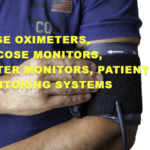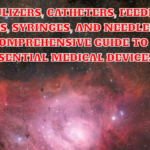Gloves, Masks, Gowns, Face Shields, Protective Eyewear: Essential Tools for Healthcare Professionals
As healthcare professionals, hospital owners, and individuals alike navigate through the ever-changing landscape of the healthcare industry, certain tools have become integral in ensuring the safety and well-being of both patients and healthcare providers. In this blog post, we will explore the importance of gloves, masks, gowns, face shields, and protective eyewear in protecting against infectious diseases and preventing the spread of harmful pathogens. We will delve into the various types of each protective gear and provide insights into their usage, effectiveness, and maintenance. So, let’s delve into this crucial topic and discover how these essential tools have revolutionized the healthcare industry.
Gloves: The First Line of Defense
One of the most vital and ubiquitous tools in healthcare settings are gloves. These protective coverings shield healthcare providers from exposure to infectious agents and prevent cross-contamination. Gloves come in various materials, including latex, vinyl, and nitrile. While latex gloves offer excellent tactile sensitivity, individuals with latex allergies may opt for vinyl or nitrile gloves. It is crucial to choose gloves that fit properly, ensuring a snug and comfortable fit.
Proper glove usage includes donning gloves before entering a patient’s room or initiating any contact with potentially contaminated surfaces. Gloves should be changed between patients or when moving from a contaminated to a clean area to prevent the spread of pathogens. Additionally, gloves should never be washed or reused, as this compromises their integrity.
Masks: Safeguarding the Respiratory System
In the face of respiratory infections, masks serve as a formidable defense mechanism. They are designed to protect healthcare professionals and patients alike by filtering out airborne particles and droplets expelled during breathing, coughing, or sneezing. The most common types of masks are surgical masks and N95 respirators.
Surgical masks, often made of multiple layers of non-woven fabric, act as a physical barrier against respiratory droplets and protect others from potential exposure to the wearer’s secretions. However, they do not provide a tight seal around the face, making them less effective in filtering out tiny particles.
On the other hand, N95 respirators offer a higher level of respiratory protection. These masks are designed to provide a tight fit around the face, filtering out at least 95% of airborne particles. N95 respirators are crucial in settings where the risk of airborne transmission is high, such as during aerosol-generating procedures or when caring for patients with highly contagious respiratory illnesses.
Gowns: Shielding from Contamination
When it comes to protecting healthcare providers from contamination during direct patient care or contact with potentially infected materials, gowns play a vital role. Gowns act as an additional barrier, preventing potentially infectious substances from coming into direct contact with the skin or clothing. They are commonly made of fluid-resistant material, such as polyester or polypropylene, and come in various levels of protection.
Isolation gowns are the most basic form of protective gowns, providing a minimal barrier against fluid penetration. They are suitable for low-risk situations, where the likelihood of exposure to bodily fluids is minimal. On the other end of the spectrum, surgical gowns provide a higher level of protection, often being resistant to both fluid penetration and microbial colonization. Surgical gowns are typically used during invasive procedures to minimize the risk of surgical site infections.
Proper gown usage involves donning the gown before entering a patient’s room or engaging in any activities that may result in exposure to potentially infectious materials. Gowns should be removed and discarded promptly after use to prevent the spread of pathogens to other areas or individuals.
Face Shields: Guarding the Face
While masks protect the respiratory system, face shields provide an extra layer of protection for the entire face, including the eyes, nose, and mouth. Face shields are essential in environments where there is a high risk of exposure to bodily fluids or airborne particles. They are typically made of clear plastic material that allows for unobstructed vision while forming a barrier against splashes or sprays.
Face shields are particularly effective in combination with masks, as they provide comprehensive protection for both the wearer and those nearby. They also serve as a gentle reminder to avoid touching one’s face, reducing the risk of self-contamination.
Protective Eyewear: Safeguarding the Eyes
In a healthcare setting, protecting the eyes is just as crucial as safeguarding other parts of the body. Exposure to infectious agents through the eyes can lead to severe consequences, making protective eyewear an indispensable tool for healthcare providers.
Protective eyewear, such as goggles or glasses, forms a barrier against ocular exposure to pathogens, bodily fluids, or hazardous substances. They should fit securely and snugly to prevent any particles from entering the eyes. Proper usage involves donning protective eyewear whenever there is a potential risk for exposure, such as during procedures that generate splashes or when working in close proximity to patients with infectious diseases.
Conclusion
As healthcare professionals and hospital owners, it is of utmost importance to prioritize and invest in the essential tools that protect both patients and providers. Gloves, masks, gowns, face shields, and protective eyewear are vital components of infection prevention and control measures in various healthcare settings.
By understanding the different types of protective gear, their usage, and their effectiveness, healthcare professionals can ensure the safety and well-being of both themselves and their patients. Regular training and awareness campaigns can further enhance the proper utilization and maintenance of these essential tools.
During these challenging times, it is essential to prioritize the health and safety of healthcare professionals, as they work tirelessly to provide the best possible care to their patients. Let us remember that a collective effort to utilize and maintain these protective tools is crucial in combating infectious diseases and safeguarding the future of healthcare.



